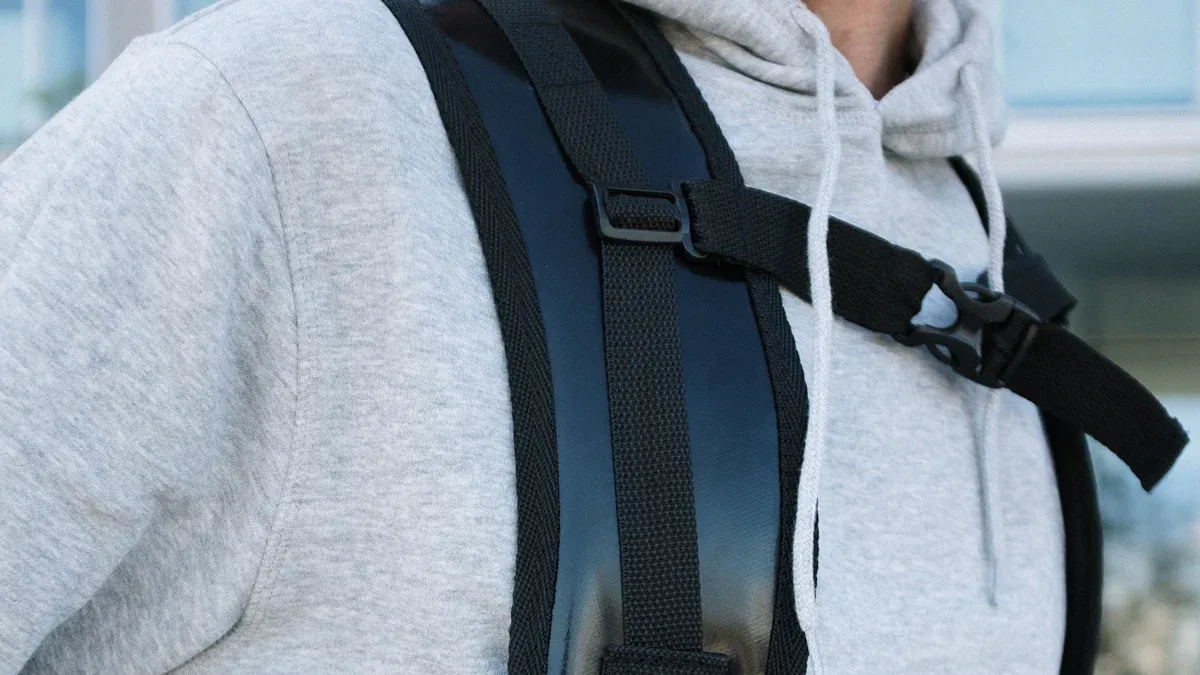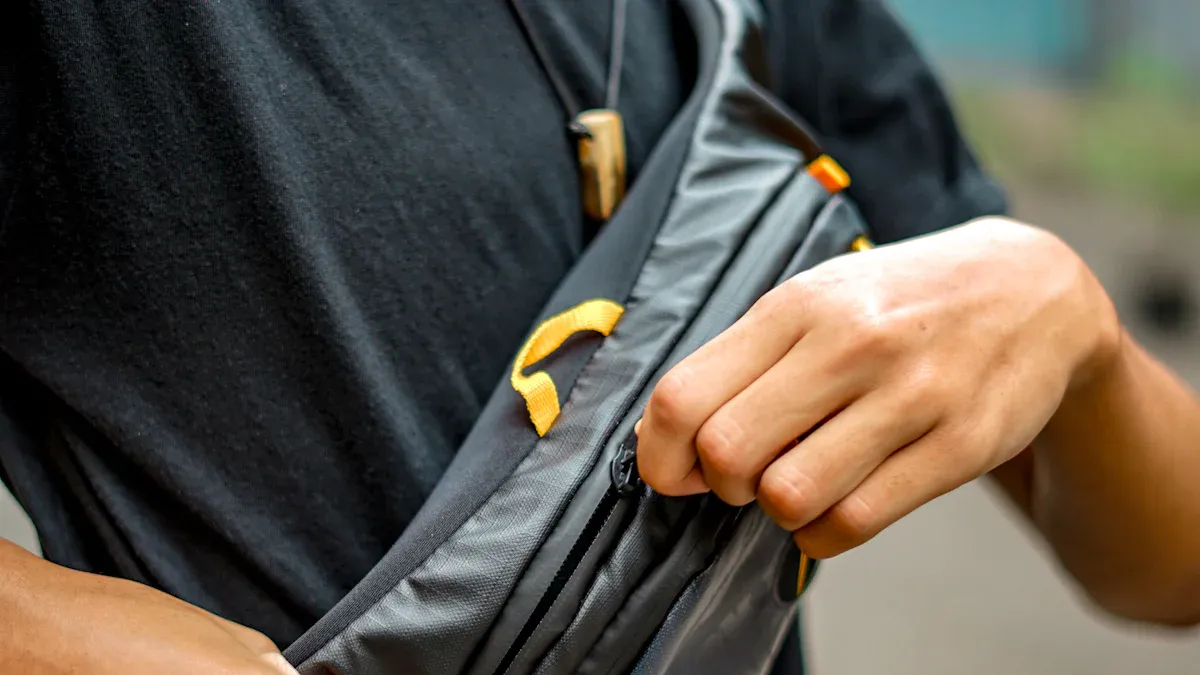Backpack Shoulder Strap Tips to Fix Waistband Fit Fast

You want your hike to feel great, right? Sometimes, your waistband just doesn’t sit right, but you can fix it fast with a simple backpack shoulder strap adjustment. Comfort matters when you’re out on the trail. Quick fixes let you keep moving without stopping for long. These tips work for beginners and seasoned hikers. You’ll find that adjusting your gear can be easy and make a big difference.
Key Takeaways
- Adjust your backpack for comfort. Start by loosening all straps to allow for easy adjustments.
- Ensure the waistband sits just below your hip bones. This helps distribute weight properly and reduces shoulder strain.
- Use the shoulder straps to keep the pack close to your body. They should feel snug but not tight, providing support without discomfort.
- Check the sternum strap and load lifters. These adjustments help maintain an upright posture and prevent pressure points.
- Make quick adjustments on the go. Small tweaks can enhance comfort and prevent pain during your hike.
Why Fit Matters
Comfort and Endurance
You want to enjoy your hike, not just finish it. The right fit makes a huge difference in how you feel on the trail. When your backpack fits well, you move easier and keep your energy up. Research shows that a good fit and smart load management help you hike longer without getting tired too fast. If your pack feels right, your heart rate stays lower, and you can handle more weight without feeling worn out. Regular training helps, but nothing beats a pack that fits your body. You’ll notice that comfort improves when you pay attention to fit from the start.
Preventing Pain
A poor fit can turn a fun hike into a painful struggle. Many hikers report sore muscles, aches, and discomfort when their packs don’t fit right. You might feel pressure points or numbness if your straps are too tight or the waistband sits wrong. Here are some common problems hikers face when the fit is off:
| Problem Type | Description |
|---|---|
| Hot Spots and Pressure Points | Develop where the pack excessively contacts the body, often due to poor fit or adjustment. |
| Load Distribution Issues | Occurs when the pack feels unbalanced, pulling the hiker backward or forward due to improper packing. |
| Numbness and Circulation Problems | Results from overly tight shoulder straps or incorrect positioning, leading to restricted circulation. |
You can avoid these issues by checking your fit before you hit the trail.
Weight Distribution
Weight distribution is key for safety and balance. When you get the fit right, you keep heavy items close to your back and centered. This helps you stay steady, even on rough ground. A good fit improves your center of gravity and lowers your risk of falling. You also save energy because your body doesn’t have to work as hard to stay upright. Try to pack heavier items in the middle of your backpack. Don’t put heavy things on top, or you might tip backward. Good weight distribution means you move with confidence and avoid injuries. You’ll find that a proper fit and smart weight distribution work together to make every hike better.
Adjustment Technique

Getting your backpack to feel just right can seem tricky, but you can master it with a simple step-by-step technique. Let’s break it down so you can hit the trail feeling comfortable and confident.
Loosen All Straps
Start by loosening every strap on your backpack. This step gives you room to move and makes it much easier to adjust the fit. When you loosen all the straps, you:
- Give yourself breathing room to work with the pack.
- Make it easier to shift the weight around for better comfort.
- Avoid the pain of tight straps digging in before you’re ready.
You want your backpack to feel like it’s made for you, not the other way around. Loosening everything first helps you get there.
Waistband Fit and Position
Next, focus on the waistband. Slide your backpack on and let it rest on your hips. The waistband should sit just below your hip bones, not on your waist. Outdoor gear experts say you want the padded wings to cover your hip bones. The pads should sit so half is above and half is below the top of your iliac crest. This spot lets your hips carry most of the weight, taking pressure off your shoulders.
- The padded wings should cover your hip bones.
- The hip belt moves most of the pack’s weight to your hips.
- The pads should sit half above and half below the top of your hip bone.
Pull the waistband snug, but don’t make it too tight. You want it to feel secure, not like it’s squeezing you. If you get this step right, you’ll notice your backpack feels lighter and more stable.
Tip: If your waistband slips or feels loose, stop and readjust. A good fit here makes the rest of the process much easier.
Backpack Shoulder Strap Adjustment
Now it’s time to work on the backpack shoulder strap. Pull the straps down and back until they feel snug against your shoulders. You don’t want them to carry all the weight. Instead, they should keep the pack close to your body and steady as you walk. If you feel the straps digging in, loosen them a little. The right adjustment means your shoulders feel supported, not strained.
Different backpack designs can make this step easier or harder. Some packs have advanced harness systems that help reduce muscle strain, especially when you stand upright. These designs let you adjust the backpack shoulder strap more easily and keep your muscles from working too hard. If you bend forward a lot, you might notice the benefits less, but for most hikes, these features make a big difference.
Sternum Strap and Load Lifters
Finish by adjusting the sternum strap and load lifters. Clip the sternum strap across your chest and tighten it just enough to keep the shoulder straps in place. Don’t pull it too tight—you still want to breathe easily.
Load lifters are the small straps near the top of your backpack shoulder strap. Pull them until the top of the pack tilts slightly toward your shoulders. This move helps you stand tall and keeps the load close to your spine. Here’s what these straps do for you:
- Load lifters help you keep an upright posture by aligning the pack with your spine.
- They let you fine-tune how the backpack sits, making it more comfortable and stable.
- By shifting weight off your shoulders, load lifters reduce strain and stop hot spots from forming.
Note: If your backpack feels off-balance or you notice pain, try small tweaks to the sternum strap and load lifters. Sometimes a tiny change makes a huge difference.
When you adjust the fit in this order—waistband, backpack shoulder strap, sternum strap, and load lifters—you set yourself up for a comfortable hike. Each step helps move weight where your body can handle it best. You’ll feel less tired, avoid sore spots, and enjoy your time outdoors even more.
Quick Fixes for Uncomfortable Backpack

On-the-Go Adjustments
You don’t have to stop for long when your backpack starts to feel off. Quick tweaks can help you fix an uncomfortable backpack while you’re still moving. Try these steps:
- Fasten the hip belt at hip level, right above your glutes.
- Make sure the top of the hip belt sits about an inch above your hip bones.
- Tighten the hip belt to keep your pack stable.
- Use wide, padded shoulder straps that contour to your body. The top of the strap should sit 1-2 inches below your shoulders.
- Position the bottom of your backpack at the small of your back, not more than 4 inches below your waistline.
- Distribute weight evenly and keep heavier items close to your spine.
- Wear your backpack high and tight, not low and loose.
Tip: If your uncomfortable backpack keeps slipping or feels heavy, check your hip belt and shoulder straps first. Small changes can make a big difference.
Fast Relief for Hot Spots
Hot spots can ruin a hike fast. You can fix them before they turn into blisters or sore spots. Here’s what you can do:
- Adjust the hip straps and torso length so most of the weight sits on your hips.
- Use the 80/20 rule: 80% of the weight should be on your hips, 20% on your shoulders.
- Fine-tune shoulder straps to avoid overtightening.
- Adjust load lifters and sternum straps to keep a natural fit and prevent pressure points.
If you feel a hot spot, stop and make these changes right away. You’ll notice your uncomfortable backpack feels much better.
When to Stop and Refit
Sometimes, quick fixes aren’t enough. If your uncomfortable backpack keeps causing pain or feels unstable, it’s time to stop and refit. Here’s when you should take a break:
- The waist strap isn’t snug around your hips.
- Shoulder straps feel too tight or too loose.
- Load lifters don’t sit at a 45-degree angle.
- The chest strap feels too tight or restricts breathing.
Note: Good posture helps too. Stand tall and keep your spine neutral. If you’re hiking uphill or downhill, adjust your gait and use hiking poles for balance. These steps protect your back and shoulders and keep your hike enjoyable.
Troubleshooting Size and Fit Issues
Slipping Waistband
A slipping waistband can ruin your hike. You might notice your pack sliding down, making you stop often. This usually happens when the waistband is not the correct size or isn’t tight enough. Always buckle the hipbelt at the middle of your waist and pull it tight. Make sure the wide sides of the hipbelt sit right on your hip bones. Most of the load should rest on your hips, not your shoulders. If your waistband keeps slipping, check these things:
- Adjust the shoulder straps so they fit snugly against your back.
- Use a sternum strap to connect the shoulder straps and keep everything in place.
- Replace any low-quality buckles that don’t hold well.
- Keep your pack’s weight under 10-15% of your body weight.
Tip: If you still have trouble, your pack might not be the correct size for your body. Try a different size for a better fit.
Shoulder Pain
Shoulder pain is a common problem, especially if your backpack is not the right size or you pack too much. You want to avoid pain by making sure your pack does not exceed 25-30% of your body weight. Always use both shoulder straps to help with even distribution. Here are some ways to fix shoulder pain:
- Adjust the straps so the pack feels snug but not too tight.
- Pack heavier items close to your back for better support and distribution.
- Clean out non-essential items to reduce the load.
- Choose a backpack with wide, padded straps for comfort.
- Make sure the bottom of your pack sits no more than four inches below your waist.
Remember: A proper fit and the right size pack can prevent pain and keep you comfortable.
Uneven Load
Uneven load distribution can make your backpack feel awkward and unstable. You might notice your pack pulling to one side or causing you to lean. This often happens when you use only one strap or pack items unevenly. To fix this, always use both shoulder straps and make sure the load is balanced. Here’s what helps:
- Place heavier items closest to your back for better distribution.
- Use a hip belt and shorter, non-flexible shoulder straps to improve comfort and load distribution.
- Avoid wearing a single strap backpack, as it can cause discomfort and poor posture.
- Check that the load lifters meet the shoulder straps at about a 45-degree angle.
A good size and fit, along with smart distribution, will help you hike longer without pain. If your pack still feels off, try repacking or adjusting the straps until you find the proper fit.
Pro Tips for Lasting Fit
Preventative Adjustments
You want your backpack to feel great every time you hit the trail. Before you go, always check how to wear your backpack for the best comfort. Start by measuring your torso length and measure your hip size. These steps help you find the right fit and avoid pain. When you pack, put heavy items in the middle, close to your back. Place lighter gear at the bottom or in outside pockets. Keep snacks and water in easy-to-reach spots. Adjust the hip belt so it sits right on your hip bones and feels snug. This step moves about 70-80% of the weight to your hips. Make sure the straps form a smooth arc and do not dig into your shoulders. If you use an adjustable shoulder harness, check that it sits one or two inches below the top of your shoulders.
Tip: Always double-check your measurement before you leave. A good torso measurement and hip belt fit make a big difference.
Regular Strap Care
Straps work hard to keep your pack steady and comfortable. You should check them before every hike. Look for fraying or loose stitching. Clean your straps every week or two to remove dirt and sweat. If you hike a lot, give your straps a deep clean every month. Adjustable straps need extra attention. Make sure buckles and sliders move smoothly. If you spot damage, fix it right away. A strong shoulder harness and hip belt give you the support you need.
- Check all straps for wear and tear.
- Clean straps regularly to keep them strong.
- Test adjustable parts for smooth movement.
Repacking for Better Fit
Sometimes, you need to repack to get the best balance. Start by putting heavy items close to your body and at the bottom of your pack. Use compression sacks for bulky gear. Roll your clothes to save space. Distribute weight evenly from side to side. Walk around with your pack and see how it feels. If you lean or feel off-balance, adjust your straps or repack. Keep water bottles and snacks in hip belt or chest pockets for easy access. Use the adjustable shoulder harness and hip belt to fine-tune your fit. If you want to reduce pack weight, remove non-essential items.
Remember: Learning how to wear your backpack and using the adjustable straps and shoulder harness will help you stay comfortable all day. Check your fit often, especially on long hikes. Your hip belt and straps should always support you.
You now know how to adjust your backpack shoulder straps and waistband for the best fit. When you hike, always check how the weight feels on your hips and shoulders. Shift the weight to your hips first, then use the straps to balance the weight across your back. If you feel the weight pulling or the weight pressing in the wrong spot, stop and fix it. You want the weight to stay close to your body. Try these steps before you hike and during your trip. Small changes in weight placement can make your hike much better. Do you have your own weight tips or stories? Share them in the comments!
FAQ
How tight should my backpack waistband feel?
You want your waistband snug but not squeezing. It should sit right on your hip bones. If you can slide two fingers under the belt, you have the right fit.
What do I do if my shoulder straps keep slipping?
Try tightening the sternum strap. Make sure both shoulder straps match in length. If they still slip, check for worn-out buckles or padding.
Can I adjust my backpack while hiking?
Yes! You can make quick tweaks on the trail. Pull the hip belt tighter or loosen the shoulder straps. Small changes help you stay comfortable without stopping.
Why does my backpack hurt my back?
Your pack might be too heavy or the weight sits too far from your body. Move heavy items close to your spine. Adjust the hip belt and shoulder straps for better support.
See also
5 Items That Every Mountaineer Should Have in Their Bag
Step by Step Guide to Carrying a Heavy Backpack Correctly
Why Breathable Material is Important for Hiking Bags
12 Most Beautiful Hiking Trails in the United States for 2025



Comments are closed